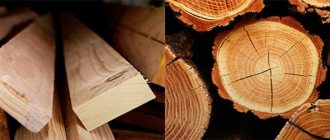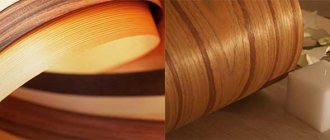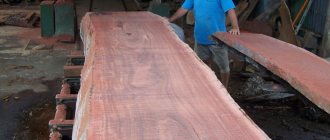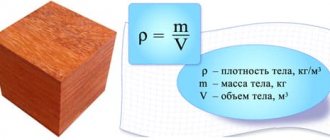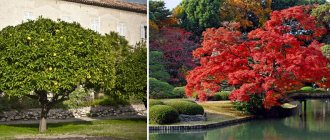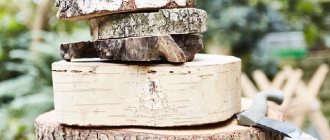Coniferous trees
Coniferous species have a sharper, resinous odor. In addition, the macrostructure of such wood species is better defined than that of deciduous trees. Coniferous wood species include pine, larch, fir, spruce, and cedar.
Pine
Pine is most often used as a building material. The color of pine wood can be either reddish-yellow or pale yellow, and this does not in any way affect the working properties of the wood. The wood itself is durable, light, and easy to process. In addition, due to the high resin content, the wood is very resistant to rotting and weathering. The soft structure of wood allows it to easily absorb various dyes. This also applies to varnish coatings. When dried, pine wood practically does not warp.
Spruce
Spruce is the second most important and used coniferous species. Compared to pine, spruce is in many ways inferior to it. First of all, this is caused by a large number of knots in the wood. Yes, and it lends itself to processing somewhat less easily. The wood contained slightly less resin, which affects its poor resistance to atmospheric conditions.
Cedar
Cedar, or Siberian pine, is not inferior to spruce in construction qualities, and sometimes even surpasses it. Cedar wood is very easy to work with, but just like spruce, it is not resistant to decay.
Fir
In terms of its working qualities, fir is not much different from spruce: it is easy to process and practically does not accept chemicals. Just like spruce wood, it contains little resin, which is why the wood quickly rots in the open air without special treatment.
Deciduous trees
Deciduous wood species are divided into hardwood and softwood. Wood of such species has practically no smell, and the smell intensifies only when the wood is freshly cut and processed. The most commonly used hardwood species are oak, birch and ash. The most common softwood species are aspen and alder.
Oak
Oak is most often used in furniture making. Oak furniture is considered the most beautiful and durable; in addition, dense wood allows you to decorate the details with relief carvings. Also, the strength and hardness of wood contributes to the production of small fasteners, but at the same time durable connections. Oak is one of the few types of wood from which bent parts of various radii can be made. Due to the high content of tannins in wood, oak is considered the most rot-resistant of all deciduous species.
Beech
Beech is also a hardwood species. Its qualities are practically not inferior to oak. Just as good as oak, it can be processed, bent and impregnated with various chemical solutions. This quality contributes to the durability of the varnish and paint coating. But due to the fact that beech warps greatly when drying and is susceptible to rotting with the formation of wormholes, it is little used in the manufacture of furniture.
Ash
Ash is most often used in the manufacture of furniture, veneer and parquet. This widespread use of ash is due, first of all, to the qualities of its wood: strong, tough, durable, resistant to decay, with a beautiful textured pattern, which warps little when dried and bends well when steamed.
Birch
Birch is used a little less frequently than ash. First of all, this is due to low resistance to rotting, high shrinkage and susceptibility to warping. But the birch wood itself lends itself well to processing and makes it possible to make fine relief carvings. In addition, birch wood is well impregnated with chemicals and holds the varnish coating well.
Elm, birch bark, elm
Elm, birch bark, and elm are one species. Among the main qualities that this type of wood has are: density, strength, viscosity and low porosity. When dried, the wood practically does not warp or crack. In addition, after steaming, the wood can bend as you wish. But due to its dense and finely porous structure, wood is difficult to polish, planed and painted.
Nut
Walnut has beautiful wood and is intended for finishing work. It is well processed, can be polished and impregnated with chemicals. Heavy and durable walnut wood does not warp or rot.
Softwoods
Aspen
Aspen has soft wood with few knots. Aspen lends itself well to processing, but due to its porous structure, small parts can break almost during their manufacture.
Poplar
Poplar is also a soft-leaved species. This wood makes beautiful small parts and products. But poplar is prone to rotting, and when it dries out, it warps and cracks.
Alder
Alder, of all soft-leaved species, is most often used in the construction of houses and in the manufacture of furniture. Alder practically does not rot, and therefore it is often used in the construction of log houses for wells. It is also well used in the construction of storage rooms - it itself does not smell and does not absorb odors.
Linden
Linden, among all soft-leaved species, is valued in the manufacture of large carved parts for furniture. In addition, this is one of the few types of wood that does not warp or crack when dried. Linden has a strong structure that is resistant to rotting.
Ornamental trees
Hardwood
Deciduous species are trees or shrubs, mainly with blade-like, petiolate leaves and branched veins of the leaf blade. Most species of deciduous trees growing in Russia shed their leaves for the winter.
In evergreen deciduous trees, the leaves fall gradually. They differ from coniferous species in the more complex structure of their reproductive organs, wood and leaves, more advanced processes of pollination and fertilization, and others. On the territory of Russia, the most common representatives of the family are Birch (Betulaceae), Beech (Fagaceae), Elm (Ulmaceae), Willow ( Salicaceae Rosaceae, etc. Among deciduous species there are many valuable tree species that produce expensive and especially valuable wood (oak , ash, walnut, birch, etc.), fruits (walnut, hazel, apple, pear, etc.), cork (cork oak, Amur velvet), gutta-percha (euonymus), tannins (oak, willow), spices (laurel , rod). Among the deciduous trees there are many melliferous plants (linden, maple, apple, pear, cherry, etc.), ornamental plants, medicinal plants, etc.
Deciduous species are divided into broad-leaved and small-leaved . Broad-leaved include trees with wide leaf blades (oak, beech, maple, hornbeam, linden, etc.); small -leaved - with small small leaves (birch, aspen, alder).
Depending on the density of the wood, deciduous species are divided into hardwood and softwood . Hardwood trees are oak, ash, maple, beech, hornbeam, stone, iron and dark-bark birch, black locust and others, the wood of which is very dense. Soft-leaved include aspen, alder, some types of birch, linden, poplar, and tree willows.
Among deciduous trees there are also long-lived trees, such as oak and sycamore, which live up to 1000 years or more, and short-lived ones - birch and poplar, whose age, as a rule, does not exceed 60 years.
There are very large trees, for example eucalyptus trees over 100 m high. Some deciduous trees prefer fertile soils (linden, hazel, ash), others are undemanding to soil conditions (birch).
Among the deciduous species there are frost-resistant (birch, aspen, linden) and heat-loving (marrow, honey locust, birch bark, apricot), light-loving fast-growing (birch, poplar) and shade-tolerant with slow growth (beech, linden, hornbeam), moisture-loving (alder, willow) and drought-resistant (saxaul, tamarix, oleaster, pistachio, etc.), salt-tolerant (locust locust, saxaul, sumac).
Plantations of deciduous trees occupy vast spaces, forming deciduous and coniferous-deciduous forests, the role of which is very great for the biosphere. They are one of the main suppliers of oxygen on the planet.
Conifers
Conifers are representatives of the division of gymnosperms. The coniferous class includes 8 botanical families: Araucariaceae , Podocarpaceae , Capitaceae , Yew , Pine , Taxodiaceae and Cypressaceae .
They include about 55 genera and 600 species. Most conifers have needle-shaped (needles) or scaly leaves; they persist on plants for several years, with the exception of the Larch genus. Coniferous wood consists of tracheids with bordered pores; there are no vessels; All conifers have resin ducts.
Conifers grow mainly in the temperate zone of both hemispheres. The most common genera are: pine, spruce, fir, larch, less often - juniper, yew, thuja, cypress, etc.
The pine family is of primary importance for forestry in the Russian Federation . From this family there are 4 genera - tree species growing wild in Russia: pine , spruce , larch , fir .
The value of conifers growing in Russia is extremely high. Being the main forest-forming species, they perform the most important environment-forming, water-regulating, soil-protective, and ecological functions over vast territories. Coniferous species are the most important suppliers of wood and many products of its processing, including pulp and paper, rosin, turpentine, etc. The seeds of some coniferous species (Siberian pine and pine, etc.) are eaten and oil is obtained from them. Pine flour is made from dried pine needles or pine and spruce branches - vitamin-rich food for farm animals. The resin released by conifers is used in pharmacology and the chemical industry, including paint and varnish products.
Fruit tree wood
Among the rare species that are used in carpentry and carpentry, fruit tree wood occupies a large place. The wood used mainly is from wild trees.
Pear
Pear has dense, homogeneous, beautiful wood, which is used mainly for the manufacture of small parts. It is rare that you can get a large piece of board from a pear trunk. But this is not the only reason why pears are used to decorate furniture. Its wood is designed in such a way that when cutting, the blade perfectly removes chips both in the direction of growth of the fibers and against them. In addition, the wood is polished and impregnated perfectly. There is one more feature of the pear - it can equally be classified as both hard and soft species. The wood is quite soft when raw, but if it is soaked and then slowly dried, the wood becomes very hard. Among the shortcomings, we can name only one - without a varnish coating, the wood quickly darkens and begins to rot.
Apple tree
Apple tree is one of the most beautiful and durable wood species. But after drying, the tree warps and dries out very much, so it is preferable to work only with well-dried apple trees. Just like pear, it is used for finishing furniture, making household utensils and jewelry.
Plum
Plum, like apple trees, is very susceptible to cracking and warping when dried. Hard and durable wood with many multi-colored veins is beautifully chipped and polished. Most often it is used to make jewelry and to emboss furniture. Turned utensils made from plum wood are also highly prized.
Hardwood is a natural material, it has a number of qualities such as: hardness, beautiful appearance, durability. In order to maintain an aesthetically attractive appearance, various methods are used: applying protective coatings, drying, heat treatment, etc.
The color of wood can be determined by the content of coloring and tannins in it, as well as the age of the tree, species and climatic conditions. The hotter the climate, the brighter the color of the wood. Sometimes the color of wood changes due to exposure to ultraviolet radiation or a protective coating. The color of wood can be changed by tinting.
The hardness of wood is determined by the species and growing conditions of the tree. Hardwoods are of great value because their wood is suitable for making furniture. Hardwood trees are very diverse. Their wood has a fairly dense texture. It is perfectly processed and many different products can be made from it. Hardwood trees grow in mixed forests. There are many types of hard-leaved trees growing in the forests of our country, some of them are considered long-lived.
Deciduous trees are divided into soft-leaved and hard-leaved. Hardwood species are distinguished by hard wood, these include: beech
,
ash
,
oak
,
maple
and
walnut
. Soft-leaved species include: alder, willow, aspen, birch, linden, poplar.
The peculiarity of hardwood is that it has virtually no odor. The smell is present when wood is freshly cut. This wood looks good and has excellent performance characteristics; it is suitable for floors and internal stairs.
Oak
- the most valuable type of wood. Its wood has a distinct texture and a pleasant brown color.
If the oak trunk is kept in water for a long time, it acquires strong and black wood. Such oak is many times superior in quality to ordinary oak. Oak is protected from microbial attack due to its ability to release tannins. The uses of oak are varied; it is used to make doors, window blocks and parquet strips.
Buku
The wood is typically heavy and dense and resistant to moisture. Often the color of beech is white with a slight yellowish or red tint. One of its positive qualities is that it is easy to polish. But there are also disadvantages: its wood is not durable when stored outdoors, it is advisable to use it indoors. The wood of this tree is used in the manufacture of a wide variety of products: furniture, wooden containers, measuring instruments, musical instruments, plywood, etc.
At the maple
there is hard and durable wood with a slightly yellowish color. It is easy to polish and has excellent cutting properties, so it is widely used for carving work. White maple is also grown; it has white wood that is quite wear-resistant and is used for making musical instruments, furniture and fittings, and parquet.
Linden wood
almost does not dry out and does not crack. It is quite soft, perfectly processed and does not crack. Basswood is the best material for carving; it has a uniform texture and pure white wood. It is quite highly valued; various crafts and buildings are made from its wood. Linden is also suitable for making barrel containers, furniture, plywood, etc. Our company has in stock and to order linden boards used for interior decoration of baths (check the price).
Hornbeam
- also called white beech. Its wood is very durable and ranges in color from white to gray. Its texture is quite uniform, with light dots scattered against its background. Heartwood and sapwood, almost identical in color. Hornbeam is practically not subject to warping and its hardness exceeds that of oak. It is difficult to cut.
Imported tree species
Above we looked at the types of wood that grow in our country. But in Russia, imported breeds are also very popular, which are most often used to make furniture and jewelry.
Red tree
Mahogany grows only in tropical forests. The very concept of “mahogany” does not mean belonging to a particular species, but represents a collection of various species, the wood of which is red in color. Mahogany wood is a soft species, can be processed well, is polished, and absorbs varnish. Mainly used for finishing furniture and premises. Because of its high price, it is rarely used entirely for furniture making.
Ebony
Ebony is brought to us from Madagascar, Ceylon, and the island of St. Mauritius. Although wood cracks and splits well when dried, ebony is considered the most expensive. Its wood is dense, uniform, and black in color. Wood with barely noticeable layers of growth rings and vessels is highly valued. The least valued is wood with whitish layers and macrostructures and cores that stand out against the background of the wood. The wood practically does not rot, does not warp when dried, and absorbs varnish perfectly. The only thing that is not permissible to do with ebony is polishing: this only worsens the appearance.
Eucalyptus
Eucalyptus has durable, heavy wood that is virtually resistant to rot. This property is explained by the high content of essential oils in its structure, which act in the same way as the resin in pine wood. Eucalyptus belongs to a small number of tree species that are difficult to process. Most often, the base of furniture is made from eucalyptus, then it is decorated with inserts from other species or covered with mahogany or ebony veneer.
Fernambuc
Fernambuco is used in making mosaics. The most expensive are violin bows and conductor's batons made from this wood. When stored, fernambuco can change color from yellow with an orange tint to dark cherry or even black. Its wood practically does not rot and does not warp when dry. But a freshly felled tree dries out greatly, cracks and changes shape. In terms of severity in processing, it is second only to eucalyptus.
Rosewood
Rosewood, like most species, is imported to Russia from South America. Rosewood wood has a porous structure and a dense arrangement of thin fibers. The peculiarity of this breed is its color, which, depending on the predominance of any shade, varies from light purple to dark brown with a violet tint. Like fernambuco, it can change color over time. If the wood is not polished upon completion of the work, the color of the wood may become almost black. The wood itself can be easily processed and is not subject to rotting. Most often, furniture and all kinds of decorations are made from rosewood.
